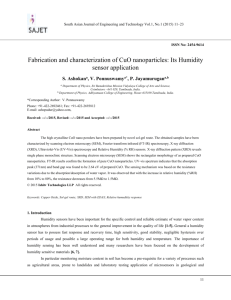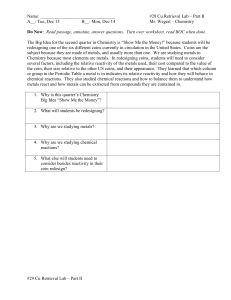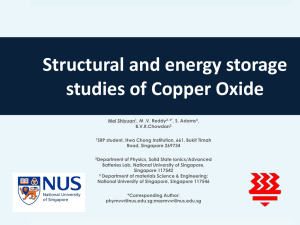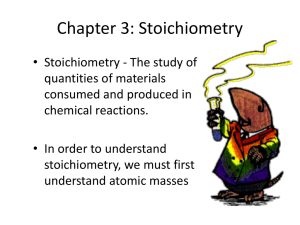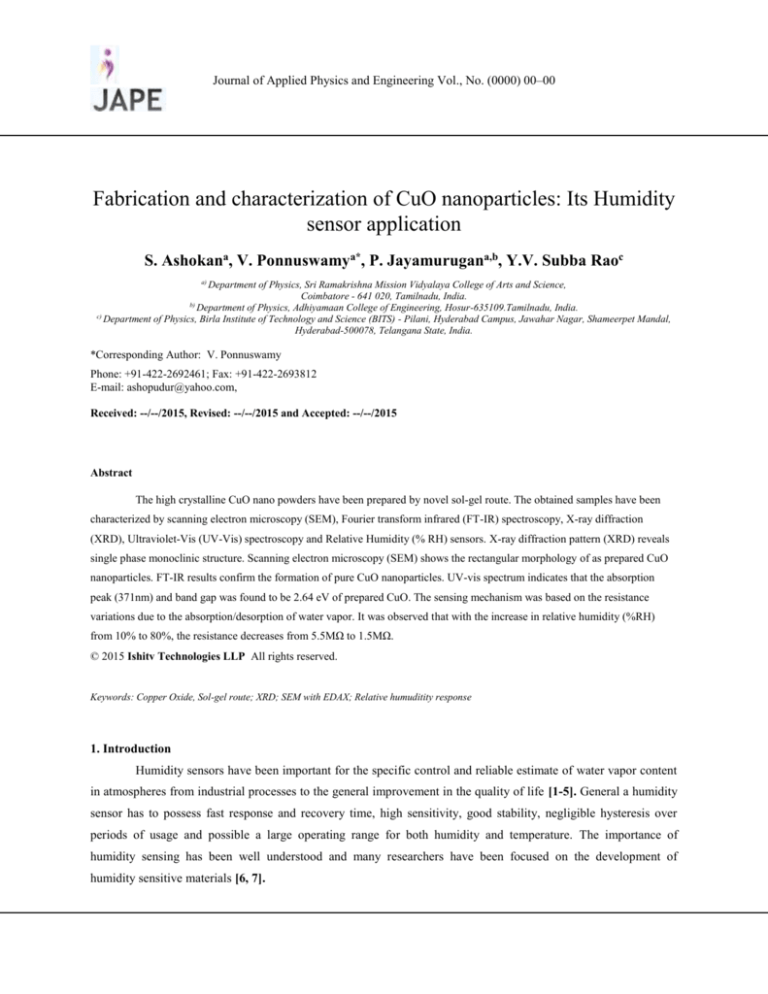
Journal of Applied Physics and Engineering Vol., No. (0000) 00–00
Fabrication and characterization of CuO nanoparticles: Its Humidity
sensor application
S. Ashokana, V. Ponnuswamya*, P. Jayamurugana,b, Y.V. Subba Raoc
a)
Department of Physics, Sri Ramakrishna Mission Vidyalaya College of Arts and Science,
Coimbatore - 641 020, Tamilnadu, India.
b)
Department of Physics, Adhiyamaan College of Engineering, Hosur-635109.Tamilnadu, India.
c)
Department of Physics, Birla Institute of Technology and Science (BITS) - Pilani, Hyderabad Campus, Jawahar Nagar, Shameerpet Mandal,
Hyderabad-500078, Telangana State, India.
*Corresponding Author: V. Ponnuswamy
Phone: +91-422-2692461; Fax: +91-422-2693812
E-mail: ashopudur@yahoo.com,
Received: --/--/2015, Revised: --/--/2015 and Accepted: --/--/2015
Abstract
The high crystalline CuO nano powders have been prepared by novel sol-gel route. The obtained samples have been
characterized by scanning electron microscopy (SEM), Fourier transform infrared (FT-IR) spectroscopy, X-ray diffraction
(XRD), Ultraviolet-Vis (UV-Vis) spectroscopy and Relative Humidity (% RH) sensors. X-ray diffraction pattern (XRD) reveals
single phase monoclinic structure. Scanning electron microscopy (SEM) shows the rectangular morphology of as prepared CuO
nanoparticles. FT-IR results confirm the formation of pure CuO nanoparticles. UV-vis spectrum indicates that the absorption
peak (371nm) and band gap was found to be 2.64 eV of prepared CuO. The sensing mechanism was based on the resistance
variations due to the absorption/desorption of water vapor. It was observed that with the increase in relative humidity (%RH)
from 10% to 80%, the resistance decreases from 5.5MΩ to 1.5MΩ.
© 2015 Ishitv Technologies LLP All rights reserved.
Keywords: Copper Oxide, Sol-gel route; XRD; SEM with EDAX; Relative humuditity response
1. Introduction
Humidity sensors have been important for the specific control and reliable estimate of water vapor content
in atmospheres from industrial processes to the general improvement in the quality of life [1-5]. General a humidity
sensor has to possess fast response and recovery time, high sensitivity, good stability, negligible hysteresis over
periods of usage and possible a large operating range for both humidity and temperature. The importance of
humidity sensing has been well understood and many researchers have been focused on the development of
humidity sensitive materials [6, 7].
Journal of Applied Physics and Engineering Vol., No. (0000) 00–00
In particular monitoring moisture content in soil has become a pre-requisite for a variety of processes such
as agricultural areas, prone to landslides and laboratory testing application of microsensors in geological and
geotechnical engineering study has emerged only recently owing to the complex boundary conditions that must be
overcome in granular materials such as three-phase solid-water-air void structure and heterogeneous particle
distributions.
Recent research in this area has focused on the measurement of suction and humidity. Metal oxides
nanostructure, as promising materials; have attracted much attention because of their extraordinary properties in
different fields of optics, optoelectronics, catalysts, biosensors and humidity sensors.
The sensors made from metal oxides like aluminum oxide, titanium oxide, tin oxide and iron oxide have
been emerged as economic humidity sensors in recent years [8-11].
Among all, cupric oxide (CuO) has attracted considerable attention because of its peculiar properties. An
important advantage of using CuO in device applications is that it is non-toxic and its constituents are available in
abundance.
In this present work, the morphological, structural, optical and relativity humidity sensing response of the
CuO nanoparticles by sol-gel route have been investigated by the Scanning electron microscopy (SEM), Fourier
transform infrared (FT-IR), X-ray diffraction (XRD), ultraviolet-visible (UV-vis) and humidity sensing properties.
2. Experimental technique
CuO nanopowders were prepared by sol-gel route method. The aqueous solution of CuCl2.6H2O (0.4 M)
was prepared in a cleaned round bottomed flask. Then 2 ml of acetic acid (CH3COOH) was added and heated at
100oC with constant stirring. Finally, 8 M of NaOH was added to above heated solution till the pH reaches to 7. The
color of the solution turned from light blue to black immediately with large quantity of black precipitate. The
precipitated is centrifuged and washed 3-4 times with de-ionized water. The obtained precipitate was dried in air for
24 h. This powders if further used for the characterization of CuO nanoparticles.
2.1 Fabrication of Sensing Pellet
The prepared CuO powders were pressed into pellets by hydraulic press (» 5MPa) for a 3 mm thickness.
Top of the pellets side was made on silver paste to take two contact lead. Fig. 1shows the schematic diagram of the
dynamic humidity chamber used for varying and measuring the humidity sensing by two thermometers. The
humidity system used consisted of a closed flask (total volume 500 ml) with three necks for inserting thermometers
and the sensor.
Journal of Applied Physics and Engineering Vol., No. (0000) 00–00
Fig. 1 Schematic experimental setup for the measurement of % RH
The flask was partially filled with water in one way neck and kept in a thermocouple container in second
neck. The external container was filled to the equal level of water (which is present in the flask) with ice. The
temperature of the system was adjusted by mixing ice and water as required. Thus the water inside the flask can be
kept at a required temperature (T1). The sensing pellet of composites was mounted inside the flask at a height of 6
cm from the surface of the water and the temperature of the sample (T2) was measured with another one
thermometer which was placed at an equal height of the sample to be studied. The humidity inside the chamber was
calculated by taking the ratio of the saturated water vapor pressure at a water temperature (T1) and the sample
temperature (T2). The values of the saturated vapor pressure were obtained from the CRC Handbook of Chemistry
and Physics. It is noted that the temperature of the sample changed by 1-9oC during the experiment.
The % RH inside the flask is given Eq. (1)
%RH = (Ew(T1)/Ew(T2))× 100
(1)
Where Ew(T1) is the saturated water vapor pressure at the temperature of water and E w (T2) the saturated
water vapor pressure at the temperature of the sensor element. Different % RH values were obtained by adjusting the
temperature of the water inside the flask with ice and water mixtures from room temperature to 0oC. The system,
equilibrium time was small and stable readings were obtained within 30 min [12].
3. Results and Discussion
3.1 Morphology of copper oxide (SEM)
Scanning Electron Microscopy (AJEOL JSM - 5610) was used to study the surface morphology of CuO
nanopowders prepared by sol-gel route method. Fig 2. (Low magnifications of 1μm) shows a spongy pattern of
swollen microstructure. A few spherical and some clusters were observed in the SEM image 5 and 10μm
Journal of Applied Physics and Engineering Vol., No. (0000) 00–00
magnifications. The images show that the nanoparticles are fine with an average grain size of about 32 nm.
Journal of Applied Physics and Engineering Vol., No. (0000) 00–00
Fig. 2 Surface morphology of CuO nanopowder at (1µm, 5 µm &10µm) different magnifications
3.2 Energy dispersive X-Ray Analysis (EDAX)
The composition of the nano powders was investigated using an energy dispersive analysis by X-ray
EDAX set up attached with scanning electron microscopy. The EDAX spectra of the prepared samples were
recorded in the binding energy 0-10 KeV as shown in Fig 3. The purity and chemical composition of the prepared
CuO nano powders were examined. The results indicated the presence of elemental Copper (Cu), and oxide (O).
Elemental atomic percentage (%) of Cu and O elements in the prepared samples is fig. 3 (inset the value). There are
no tracks of other impurities like carbon, etc. The result reveals the formation of pure Cu nanoparticles.
Journal of Applied Physics and Engineering Vol., No. (0000) 00–00
Fig. 3 Energy dispersive X-Ray Analysis of (a) prepared CuO
3.3 Structural Analysis (FT-IR)
A FT-IR spectroscopy analysis of CuO nanoparticles was scanned room 4000cm-1 to 400cm-1 using a
Thermo NicoletV-200FT-IRSpectrometerandKBrpellet technique. Fig. 4 shows the FT-IR spectra of CuO
nanoparticles. The observed peaks at 453,494,609 cm-1 correspond to the characteristic stretching vibration of Cu-O
bond in the CuO [13, 14]. There is a sharp peak observed in 609cm-1 in the spectrum on CuO nanoparticles, which is
the characteristic of Cu-O bond formation. The broad absorption peak at around 3466cm-1 is caused by the adsorbed
water molecules since the nanocrystalline materials exhibit a high surface to volume ratio absorb moisture. The
peaks observed in the conforming the formation of CuO nanoparticles.
Journal of Applied Physics and Engineering Vol., No. (0000) 00–00
Fig. 4 FT-IR Spectrum of prepared CuO nanoparticles
3.4 X-ray diffraction
The structural analysis of CuO nanopowder was recorded using an X-ray diffract meter with CuKα
radiation (λ=1.54A˚). The XRD pattern of CuO nanopowder is shown in Fig. 5. The XRD diffractogram of CuO
nanopowder consists of a single strong diffraction peak at 35.49 o (2θscale) arising from (−1 1 1 and 0 0 2) reflections
of monoclinic phase CuO. The other peaks are weak diffractions at 38.8 o, 48.7o, 53.48o, 58.33o, 61.5o, 66.2o, 68.1o
and 75.08o correspond to (0 2 0), (2 0 2), (0 1 4), (1 2 3), (2 2 2), (2 0 4), (3 1 4) and (3 0 3) reflections of CuO. The
observed diffraction peak patterns were compared with standard values of JCPDS 77-1898, 048-1548 & 80-1917.
Journal of Applied Physics and Engineering Vol., No. (0000) 00–00
Fig. 5 XRD Pattern of prepared CuO nanoparticles
Various parameters such as, lattice constants, crystallite size (D), dislocation density (δ) and micro-strain
(ԑ) was calculated from XRD studies and are listed in Table 1. The crystallite size of the CuO powder is calculated
using Debye-Scherer formula given in Eq. (2).
𝐷=
0.9 𝜆
(2)
𝛽𝐶𝑜𝑠𝜃
where D is the crystallite size, λ is the wavelength (= 0.1540 nm), βis the full width at half maximum of the peak in
radian, θ is the Bragg diffraction angle at peak position in degrees.
Table. 1
To calculate the structural parameters of pure CuO nanopowders
020
Lattice
Constant
5.05466
Crystallite
Size (nm)
46.36
Dislocation
Density(lines/m2)
0.000465
Micro
Strain
0.19
0.28
020
4.73062
30.08
0.001105
0.18
1.86
0.21
202
5.28
41.54
0.00579
0.19
53.48
1.71
0.4
014
7.0585
22.24
0.00202
0.186
58.33
1.58
0.21
123
5.9147
43.33
0.000532
0.19
61.52
1.5
0.27
222
5.2176
34.25
0.000852
0.19
66.13
1.41
0.6
204
6.3139
15.8
0.004
0.18
2 theta
d spacing
FWHM
h kl
35.49
2052
0.18
38.73
2.35
48.74
Journal of Applied Physics and Engineering Vol., No. (0000) 00–00
68.01
1.37
0.31
311
4.5679
30.92
0.00104
0.19
75.08
1.26
0.4
303
5.363
25.05
0.001593
0.19
The average crystallite size of CuO nanoparticles was calculated using Scherer’s relation and was found in
49 mm. The dislocation density and microstrain was calculated using the Eq. (3 & 4)
𝛿 = 1/𝐷2 𝑙𝑖𝑛𝑒𝑠/𝑚2
𝜖=
𝜆
𝐷𝑆𝑖𝑛𝜃
−
(3)
𝛽
(4)
𝑡𝑎𝑛𝜃
The average crystallite size, dislocation density, microstrain was found in between 32.12 mm, 0.0019
lines/m2 and micro strain 0.187 lines-2 m-2.
This case indicates that the crystallites in the CuO nanoparticles. XRD results thus confirm of pure and well
crystalline CuO nanoparticles without any impurity [15, 16].
3.5 Optical absorbance Studies
The UV-Visible absorption spectra of nano CuO are recorded at room temperature are given in Fig. 6. The
characteristic peak of CuO nanoparticle at 371 nm (Band gap is 3 eV). The first absorption band arises from π-π*
electron transition.
Optical
absorption
of
the
CuO
nanopowder
was
αhγ= B(hv-Eg)
analyzed
2
by
the
following
relationship:
Eq.5
(5)
Where B is a constant, Egis the optical band gap, α is absorption coefficient, which was calculated from the
optical absorbance (A). Fig. 6 shows the optical absorption spectrum of the CuO nanopowder. Fig. 7 shows the plot
of (αhγ)2 vs. hγ according to Eq. (5). The optical energy gap of the CuO nanopowder was determined as 2.62 eV by
extrapolating the linear portion of this plot at (αhγ)2= 0 which indicates that the direct allowed transition dominates
in the CuO powder. This band gap energy value is consistent with that of 2.60 eV reported by Liu et al. [17] and that
of 2.75 eV reported by Zhang et al. [18].
Journal of Applied Physics and Engineering Vol., No. (0000) 00–00
Fig. 6 UV-Vis absorbance spectrum of prepared CuO nanoparticles
Fig.7 Plot hν vs (αhν)2 of CuO nanopowder
3.6 Relative humidity sensing responses
Fig. 8 shows the characteristic response of CuO nanopowder as a function of relative humidity (% RH).
From the Fig.8, it can be noted that both CuO nanoparticles respond to the % RH by undergoing a change in
resistance.
Journal of Applied Physics and Engineering Vol., No. (0000) 00–00
Fig.8 Characteristic response of CuO nanopowders in a broad range of 10-80% RH
The rapidity and repeatability of the sensing behavior were examined with humidity atmospheres (10-80%
RH). The pellets of the CuO samples repeatedly exposed to 10% RH and then 80% RH atmosphere for 30s each
and the resistance change were recorded every 30s. More than successive reading is shown in fig.9. It is apparent
from the fig.9 that the resistance of the samples increased over the entire period of exposure (300s) to 80% RH. On
the other hand, when the sensors were exposed to 60% RH, the resistance decreased for another 300s. It is seen that
the results of similar on-off cycles, the similar trend of an increase and a decrease in conductivity with respect to
humidity changes was observed for the successive on-off cycles. This clearly shows that the sensor response time is
rather short and measurable response observable within 30s of time. This fast sensing is useful for the device
construction.
Journal of Applied Physics and Engineering Vol., No. (0000) 00–00
Fig.9 On-off cycles of CuO nanopowder for 40% RH at a time interval of 30s
Fig.10 Relativity humidity dependent conductivity plot of CuO nanopowders
The decrease in the resistance or increase in the conductivity with increasing humidity can be attributed to
the mobility of the dopant ion, which is loosely attached to the nanopowder by weak Vander Walls forces of
attraction. Furthermore, the water content plays also an important role in the transport properties. It has been
reported that the conductivity of nanoparticles increases when the absorb water molecule or moisture. The average
conductivity value was found to be 6.4106x10-05 S/cm.
4. Conclusions
CuO nanoparticles were synthesized by a sol-gel route method. SEM images show a homogeneous
distribution of small spherical, aggregated CuO nanoparticles. X-ray diffraction pattern (XRD) reveals single phase
monoclinic structure. FT-IR spectra indicate the formation of Cu-O band structure. The band edge-absorption peak
is found to be at 371 nm. The change in resistance with respect to % relative humidity (%RH) was observed was
exposed to a broad range of humidity (10% to 80% of RH). CuO nanoparticle showed the sensing response for a
humidity sensor.
Acknowledgement
The authors are thankful to Sophisticated Test and Instrumentation Center, Cochin, Kerala, for providing
instrumental facilities.
References
[1]. N. Yamazoe and Y. Shimizu, Sensors and Actuators, 10 (1986) 379-398.
[2]. H. Arai and T. Seiyama, Sensors: A Comprehensive Survey, VCH, Wenham, 3 (1992) 981-1012.
[3]. G. J. C. Verdijck, H. A. Preisig and G. Van Straten, Journal of Process Control, 15 (2005)235-246.
[4]. C. Chen, Biosystems Engineering, 88 (2004) 231- 241.
[5]. M. Pelino, C. Cantalini and M. Faccio, Active and Passive Electronic Components, 16 (1994) 69-87.
[6]. Y. Le, M. J. Yang and Y. She, Talanta, 62 (2004) 707-712.
Journal of Applied Physics and Engineering Vol., No. (0000) 00–00
[7]. R. V. Dabhade, D. S. Bodas and S. A. Gangal, “Sensors and Actuators B, 98 (2004) 37-40.
[8]. C. Cantalinic, M. Pelino, J. Am. Ceram. Soc. 75 (1992) 546–551.
[9]. M. Li, Y. Chen, Sens. Actuators B 32 (1996) 83–85.
[10]. H. Yagi, M. Nakata, J. Ceram. Soc. Jpn. 100 (1992) 152–156.
[11] P. chauhan, S. Annapoorni, S.K. Trikha, Thin Solid Film 346 (1999) 266–268.
[12]. P.R. Somani, A.K. Viswanath, R.C. Aiyer, S. Radhakrishnan, Org. Electron. 2 (2001) 83-88.
[13]. M.A. Dar, Y.S. Kim, W.B. Kim, J.M. Sohn, H.S. Shin, Appl. Surf. Sci. 254 (2008) 7477.
[14]. B. Balamurugan, B.R. Mehta, Thin Solid Films 396 (2001) 90.
[15]. Amrut. S. Lanje, Satish J. Sharma, Ramchandara B. Pode, Raghumani S. Ningthoujam, 1(2010)36-40.
[16]. Y. Aparna, K.Venkateswara Rao and P. Srinivasa Subbarao., IPCBEE 48 (2012).
[17]. Q. Liu, H. Liu, Y. Liang, Z. Xu, G. Yin, Mater. Res. Bull. 41 (2006) 697.
[18]. X. Zhang, D. Zhang, X. Ni, H. Zheng, Solid-State Electron. 52 (2008) 245.

